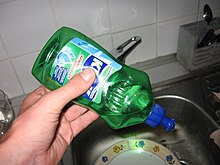
Soap is a salt of a fatty acid used in a variety of cleansing and lubricating products. In a domestic setting, soaps are surfactants usually used for washing, bathing, and other types of housekeeping. In industrial settings, soaps are used as thickeners, components of some lubricants, and precursors to catalysts.

A dishwasher is a machine that is used to clean dishware, cookware, and cutlery automatically. Unlike manual dishwashing, which relies on physical scrubbing to remove soiling, the mechanical dishwasher cleans by spraying hot water, typically between 45 and 75 °C, at the dishes, with lower temperatures of water used for delicate items.

A detergent is a surfactant or a mixture of surfactants with cleansing properties when in dilute solutions. There are a large variety of detergents, a common family being the alkylbenzene sulfonates, which are soap-like compounds that are more soluble in hard water, because the polar sulfonate is less likely than the polar carboxylate to bind to calcium and other ions found in hard water.

Surfactants are chemical compounds that decrease the surface tension or interfacial tension between two liquids, a liquid and a gas, or a liquid and a solid. The word "surfactant" is a blend of surface-active agent, coined c. 1950. As they consist of a water-repellent and a water-attracting part, they enable water and oil to mix; they can form foam and facilitate the detachment of dirt.
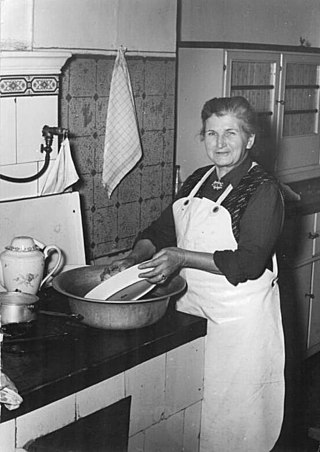
Dishwashing, washing the dishes, doing the dishes, or washing up in Great Britain, is the process of cleaning cooking utensils, dishes, cutlery and other items to prevent foodborne illness. This is either achieved by hand in a sink using dishwashing detergent or by using a dishwasher and may take place in a kitchen, utility room, scullery or elsewhere.
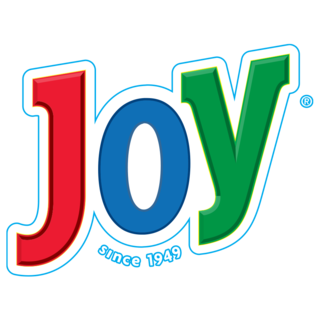
Joy is an American brand of dishwashing liquid detergent owned by JoySuds, LLC. The brand was introduced in the United States in 1949 by Procter & Gamble. In 2019, Procter & Gamble sold the rights to the Joy brand for the Americas to JoySuds, LLC.
A fabric softener or fabric conditioner is a conditioner that is applied to laundry after it has been washed in a washing machine. A similar, more dilute preparation meant to be applied to dry fabric is known as a wrinkle releaser.

Sunlight is a brand of laundry soap, laundry detergent and dishwashing detergent manufactured and marketed around the world by Unilever, except in the United States and Canada, where it has been owned by Sun Products since 2010.
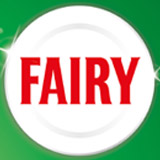
Fairy is an international brand, primarily used for washing up liquid and dishwasher detergent, owned by the American multinational consumer products company, Procter & Gamble. The brand originated in the United Kingdom in 1898 and is now used on a number of P&G products in various markets.
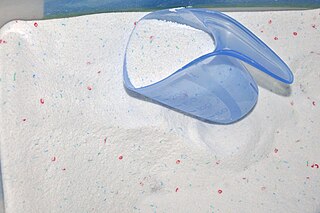
Laundry detergent is a type of detergent used for cleaning dirty laundry (clothes). Laundry detergent is manufactured in powder and liquid form.

A bubble bath is a filled bathtub with a layer of soap bubbles on the surface of the water. Less commonly, aerated or carbonated baths are called bubble baths.

Shower gel is a specialized liquid product used for cleaning the body during showers. Not to be confused with liquid soaps, shower gels, in fact, do not contain saponified oil. Instead, it uses synthetic detergents derived from either petroleum or plant sources.

Cleaning agents or hard-surface cleaners are substances used to remove dirt, including dust, stains, foul odors, and clutter on surfaces. Purposes of cleaning agents include health, beauty, removing offensive odor, and avoiding the spread of dirt and contaminants to oneself and others. Some cleaning agents can kill bacteria and clean at the same time. Others, called degreasers, contain organic solvents to help dissolve oils and fats.
A soap substitute is a natural or synthetic cleaning product used in place of soap or other detergents, typically to reduce environmental impact or health harms or provide other benefits.
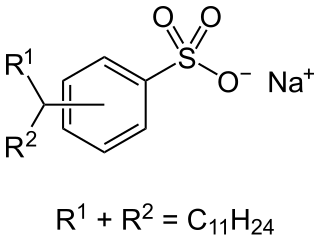
Alkylbenzene sulfonates are a class of anionic surfactants, consisting of a hydrophilic sulfonate head-group and a hydrophobic alkylbenzene tail-group. Along with sodium laureth sulfate, they are one of the oldest and most widely used synthetic detergents and may be found in numerous personal-care products and household-care products . They were introduced in the 1930s in the form of branched alkylbenzene sulfonates (BAS). However following environmental concerns these were replaced with linear alkylbenzene sulfonates (LAS) during the 1960s. Since then production has increased significantly from about one million tons in 1980, to around 3.5 million tons in 2016, making them most produced anionic surfactant after soaps.
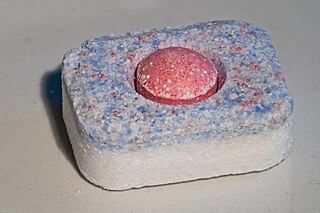
Dishwasher detergent is a detergent made for washing dishes in a dishwasher. Dishwasher detergent is different from dishwashing liquid made to wash dishes by hand.
Phosphates in detergent refers to the use of phosphates as an ingredient in a detergent product. The advantage of using phosphates in a consumer laundry detergent or dishwashing detergent is that they make detergents more efficient by chelating calcium and magnesium ions. The disadvantage of using phosphates is that they remain in wastewater and eventually make their way to a natural body of water. While phosphates are low toxicity, they instead cause nutrient pollution and feed the algae. This leads to eutrophication and harmful algal bloom.

Fabric treatments are processes that make fabric softer, or water resistant, or enhance dye penetration after they are woven. Fabric treatments get applied when the textile itself cannot add other properties. Treatments include, scrim, foam lamination, fabric protector or stain repellent, anti microbial and flame retardant.
